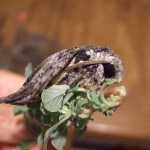Moths
Electrical engineer and neurosciences researcher Charles Higgins sees a time in the future when scientists will design robots that have the powerful vision of a moth or dragonfly, or even have such insects built in them directly to carry out phenomenal tasks involving sight and motion detection. Science fiction, you say? While Charles does admit to a healthy penchant for such flicks as Star Trek, Terminator, The Matrix and Source Code, his cutting-edge research today is steadily turning insect-inspired robotics into reality -- work that is helping scientists harness and apply the electrical…
We've all seen articles detailing remote controling insects via electric pulse systems on their nervous centers. A paper that we uncovered from last year (thanks NVDH), however, details the beginnings of a new kind of remote controlled moth. Hold on to your hats, because this is about to get complicated.
Basically, it all started when aeronautic engineers started looking closely at "insect inspired micro aircraft" as a complement to the large air vehicles that we currently employ. Large vehicles such as planes and helicopters are so massive that they are only minutely affected by changes in…
OK - I admit. I am terrified by don't like moths as it is. But this makes me creeped out by them even more than the sucking blood bit:
Source: DailyMailWhat you're looking at was formerly known as a Honda. It's been attacked by (by my guess, hundreds of thousands of) spindle ermine moth larvae (adult on R). These voracious moths-to-be spin a silk web over their feeding areas to protect themselves from ants and wasps. Normally, a silk blanket like this would be on a tree or other plant-life where the caterpillars are feeding before they pupate, but this unlucky motorist from Rotterdam has…
This is the fourth of eight posts on evolutionary research to celebrate Darwin's bicentennial.
Charles Darwin was a visionary in more ways than one. In 1862, Darwin was studying a Malagasy orchid called Angraecum sesquipedale, whose nectar stores lie inaccessibly at the bottom of a 30cm long spur (tube). Darwin predicted that the flower was pollinated by a moth with tongue long enough to raid the spur.
Few people believed him, but in 1903, zoologists discovered Darwin's predicted moth, Xanthopan morgani praedicta, and it did indeed have a very long tongue. Darwin accurately predicted the…
Cicindela has been playing with scanners and saturniid moths, to great result:
The original file must be huge! Â Worth noting that Cicindela is taking a lead from Joseph Scheer, who first perfected the technique.
Double,double, toil and trouble, fire burn and cauldron bubble...SOMETHING WICKED THIS WAY COMES!!
Anyone who knows me knows I'm terrified of moths. I get really, really, REALLY freaked out by them (especially big ones). I don't know if I watched "Silence of the Lambs" too young or what, but moths are the only thing I'm completely and irrationally afraid of. I mean, they're harmless! Right?
.............
RIGHT?(cue eerie music)
TA-DA!
Maybe my fear isn't so irrational after all. Meet a new species of Calyptra, found recently in Siberia - one of two new species of Vampire Moth. No, really.…
Just in time for Halloween, researchers in Siberia have identified a new species of vampire moth. Scratch that, make that two species of vampire moth, both discovered by Jennifer Zaspel from the University of Florida in Gainesville.
The moths are remarkably similar to a strictly vegetarian moth called the Calyptra thalictri, leading Zaspel to speculate that this blood sucking relative represents a new evolutionary direction.
For the love of God, just stop...
Regular fruit eating moths often possess hooked/barbed tongues used to get under the skin of different fruits in order to get to the…
No one quite knows when the Light Brown Apple Moth arrived on the shores of California, but after DNA identification in 2007, it wasted no time pitting the California Department of Food and Agriculture and the populace of San Francisco against one another. Today the CDFA announced a new strategy for the eradication campaign: releasing bioengineered sterile moths to lure-in amorous males.
Ever tried to neuter a moth? Not easy...
Indigenous to Australia, the non-descript moth breeds prolifically with an average of three broods generations per year. However, much like Paul Hogan before it, the…
Time once again for some of Igor Siwanowicz's spectacular insect photography. We've brought you his mantis photos in the past (#1 , #2, and #3) so we decided to switch it up and take a look at some of his moths. Unfortunately Igor doesn't tell us which species we are looking at, but maybe some of our entomologically inclined readers will chime in.
more below the fold
This last one might be a butterfly, but that's a killer proboscis...
The transformation from caterpillar to butterfly or moth is one of the most beguiling in the animal world. Both larva and adult are just stages in the life of a single animal, but are nonetheless completely separated in appearance, habitat and behaviour. The imagery associated with such change is inescapably beautiful, and as entrancing to a poet as it is to a biologist.
According to popular belief, within the pupa, the caterpillar's body is completely overhauled, broken down into a form of soup and rebuilt into a winged adult. Richard Buckmister Fuller once said that "there is nothing in a…
Male insects have a tough time of it. Aside from the usual threats of predators, competitors and the odd hungry female, many are plagued by discriminatory parasites intent on killing them, while leaving their female peers unharmed. These "male-killers" are incredibly successful and infect a wide range of insects, who are themselves a very successful group. One of these killers, a bacteria known as Wolbachia, may well be the world's most successful parasite.
The male-killers are paragons of selfishness. Their success hinges on successfully infecting females, for whithin egg cells, they find…
tags: blood droplet moth, Zygaena carniolica, Lepidoptera, Image of the Day
This red dotted animal was elected Insect of the Year 2007 by scientists at the Federal Biological Research Center for Agriculture and Forestry, Germany. Due to its markings, the moth is commonly known as "blood droplet", although its species name is Zygaena carniolica.
Image: BBC News [larger view].
tags: lepidoptera, moths, Melanchroia chephise, White-Tipped Black Geometrid, Image of the Day
White-Tipped Black Geometrid, Melanchroia chephise, Houston, Texas.
A diurnal moth, this one was photographed on the Katy Prairie NABA Butterfly Count about 30 miles NW of downtown Houston, Texas, on September 3, 2007.
Image: Biosparite [larger view].
This is a White-tipped Black Geometrid, Melanchroia chephise, although it resembles some of the wasp mimics in the Tiger Moth Family. [read more about it]

